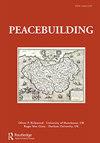Non-state conflicts, peacekeeping, and the conclusion of local agreements
IF 1.1
3区 社会学
Q2 INTERNATIONAL RELATIONS
引用次数: 5
Abstract
ABSTRACT Much of the quantitative conflict resolution literature focuses on peacemaking efforts aimed at resolving international conflict or civil wars that involve state forces, while ignoring non-state conflict between communal groups, rebel groups, or militias. This article aims to contribute to filling this gap in research. I first put forward a typology of non-state conflicts, based on two dimensions: (1) whether the conflict issues are local or national; and (2) whether the conflict parties receive external support or not. Next, I provide some descriptive statistics on the conclusion of peace agreements in non-state conflicts, which suggest that in locations of peacekeeping operations, the involvement of peacekeeping staff in negotiations makes these negotiations more likely to end in the conclusion of an agreement. The article considers several possible causal mechanisms that drive this effectiveness, including the arranging of logistics, the provision of security, and mitigating biases of relevant stakeholders.非国家冲突,维和,以及地方协议的达成
摘要:许多定量冲突解决文献侧重于旨在解决涉及国家军队的国际冲突或内战的缔造和平努力,而忽略了社区团体、反叛团体或民兵之间的非国家冲突。本文旨在填补这一研究空白。我首先基于两个维度提出了非国家冲突的类型:(1)冲突问题是地方性的还是国家性的;以及(2)冲突各方是否得到外部支持。接下来,我提供了一些关于非国家冲突中缔结和平协议的描述性统计数据,这些数据表明,在维和行动所在地,维和人员参与谈判使这些谈判更有可能以缔结协议告终。这篇文章考虑了驱动这种有效性的几种可能的因果机制,包括物流安排、安全保障和减轻相关利益相关者的偏见。
本文章由计算机程序翻译,如有差异,请以英文原文为准。
求助全文
约1分钟内获得全文
求助全文

 求助内容:
求助内容: 应助结果提醒方式:
应助结果提醒方式:


